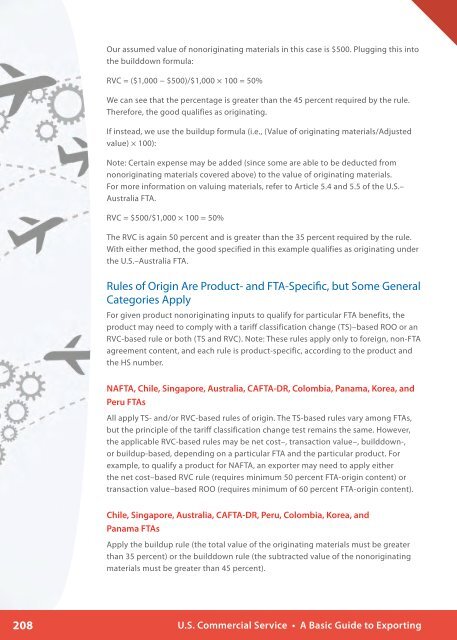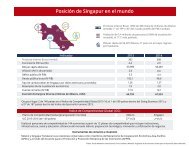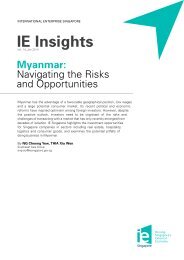- Page 1 and 2:
A BASIC GUIDE TOEXPORTINGThe Offici
- Page 3:
export.gov/basicguideLibrary of Con
- Page 6 and 7:
Table of ContentsChapter 1: Introdu
- Page 8:
global GDP and 30 percent of global
- Page 11:
A GEE might consist, for example, o
- Page 14 and 15:
Success StoryPedaling Through Trial
- Page 16 and 17:
Chapter 2Developing anExport Strate
- Page 18 and 19:
specified in the EAR under a specif
- Page 20 and 21:
All U.S. businesses have many ways
- Page 23 and 24:
Answer these 11 questions:1. Which
- Page 25 and 26:
Product or Service• What need doe
- Page 27 and 28:
Sample Outline of anExport PlanTabl
- Page 29 and 30:
5. Current Trends and Practices•
- Page 31 and 32:
16. My Product’s Harmonized Code
- Page 33:
Success StoryDownloading NewInterna
- Page 36 and 37:
This last advantage is especially i
- Page 38 and 39:
Gathering and evaluating secondary
- Page 40 and 41:
Drawing ConclusionsAfter analyzing
- Page 42 and 43:
United Nations Statistical Yearbook
- Page 44 and 45:
Private-Sector Product and Industry
- Page 46 and 47:
Success StoryHelping Feed the World
- Page 48 and 49:
Chapter 4Export AdviceIn this chapt
- Page 50 and 51:
Some of the more important services
- Page 52 and 53:
the important difference that the b
- Page 54 and 55:
at no cost to the small business ex
- Page 56 and 57:
A commercial bank can perform many
- Page 58 and 59:
location and construction of manufa
- Page 60 and 61:
To prevent reverse engineering in C
- Page 62 and 63:
We are agnostic on the question of
- Page 64 and 65:
Distribution ConsiderationsHere are
- Page 66 and 67:
Often, the first company does not p
- Page 68 and 69:
your ability to terminate agreement
- Page 70 and 71:
Once your company has prequalified
- Page 72 and 73:
Choosing a ForeignRepresentative or
- Page 74 and 75:
Success StoryDon’t Wait—Innovat
- Page 76 and 77:
Chapter 6Finding QualifiedBuyersIn
- Page 78 and 79:
companies are available from many p
- Page 80 and 81:
Trade Fair Certification Program (e
- Page 82 and 83:
Millennium Development CorporationT
- Page 84 and 85:
Who Is the “Ideal”International
- Page 86 and 87:
Scores of new franchising concepts
- Page 88 and 89:
Success StoryCast a Wide Net to Cat
- Page 90 and 91:
Chapter 8Preparing YourProduct for
- Page 92 and 93:
You can also contact the Office of
- Page 94 and 95:
training seminars, or DVDs. Zeigler
- Page 96 and 97:
The ChallengeSmith first looked tow
- Page 98 and 99:
encompasses services in transportat
- Page 100 and 101:
give U.S. companies a competitive e
- Page 102 and 103:
Success StoryRecruiting New Franchi
- Page 104 and 105:
Chapter 10International LegalConsid
- Page 106 and 107:
For more information from the U.S.
- Page 108 and 109:
When goods enter a bonded warehouse
- Page 110 and 111:
under the UCC. Older works may also
- Page 112 and 113:
Trade names are also protected on a
- Page 114 and 115:
knowledge, in turn, promotes furthe
- Page 116 and 117:
prevent him or her from obtaining a
- Page 118 and 119:
Business-to-Consumer E-Commerce Wor
- Page 120 and 121:
Because such a website is often sta
- Page 122 and 123:
An online exporter may choose to pu
- Page 124 and 125:
important to identify and incorpora
- Page 126 and 127:
other business contacts) options re
- Page 128 and 129:
Success StoryGrowing Strong withInt
- Page 130 and 131:
Chapter 12Shipping YourProductIn th
- Page 132 and 133:
One popular method of shipment is t
- Page 134 and 135:
Certificate of ConformityRequired b
- Page 136 and 137:
The cost of the shipment, delivery
- Page 138 and 139:
To learn more about comprehensive r
- Page 140 and 141:
China but needed to do a lot of hom
- Page 142 and 143:
price is too high, the product or s
- Page 144 and 145:
CompetitionIn the domestic market,
- Page 146 and 147: Commonly Used TermsIt is important
- Page 148 and 149: Success StoryAligning Innovationwit
- Page 150 and 151: Chapter 14Methods ofPaymentIn this
- Page 152 and 153: Letters of Credit and Documentary C
- Page 154 and 155: You must provide documentation show
- Page 156 and 157: associated with open-account trade
- Page 158 and 159: payment. This is because the export
- Page 160 and 161: ut they were willing to make the sm
- Page 162 and 163: • The need for preshipment financ
- Page 164 and 165: Thus it is in your best interest to
- Page 166 and 167: to support ongoing export sales or
- Page 168 and 169: To be eligible, a business must hav
- Page 170 and 171: Medium Enterprise Department and OP
- Page 172 and 173: Success StoryManufacturingInternati
- Page 174 and 175: Chapter 16Business TravelAbroadIn t
- Page 176 and 177: Planning an ItineraryTravel agents
- Page 178 and 179: Business Culture TipsAlways answer
- Page 180 and 181: Gift giving is an important part of
- Page 182 and 183: particularly intense issue. So the
- Page 184 and 185: Here are a few suggestions.• Expe
- Page 186 and 187: Building a Working RelationshipOnce
- Page 188 and 189: negotiations and agreements with it
- Page 190 and 191: Chapter 18Rules of Originfor FTAsIn
- Page 192 and 193: 5. Determine if the foreign content
- Page 194 and 195: The original ROOs are listed in an
- Page 198 and 199: Israel, Jordan, Morocco, Bahrain, a
- Page 200 and 201: The importer may ask the exporter w
- Page 202 and 203: Generic CertificatesIf a good does
- Page 204 and 205: Architectural Association of Kenya
- Page 206 and 207: Appendix A: Glossary of TermsAdvanc
- Page 208 and 209: Export-Import Bank of the United St
- Page 210 and 211: Market SurveyReport that provides a
- Page 212 and 213: Appendix B: Definitions of Abbrevia
- Page 214 and 215: Appendix D: FormsHere, you will fin
- Page 216 and 217: 228U.S. Commercial Service • A Ba
- Page 218 and 219: Tech International1000 J Street, N.
- Page 220 and 221: COMMERCIAL INVOICESELLER: INVOICE N
- Page 222 and 223: Copyright © 1998 UNZ & CO.SHIPPER/
- Page 224 and 225: DEPARTMENT OF HOMELAND SECURITYU.S.
- Page 226 and 227: PACKING LIST© Copyright 2001 Unz &
- Page 228 and 229: 1a. U.S. PRINCIPAL PARTY IN INTERES
- Page 230 and 231: U.S. $13220of this FIRST of Exchang
- Page 232 and 233: IndexAA2ASee account-to-account (A2
- Page 234 and 235: Global Entrepreneurship Ecosystem (
- Page 236 and 237: Swinko, RonSee Jet IncorporatedSzuc
- Page 238 and 239: International OfficesAfghanistanKab





